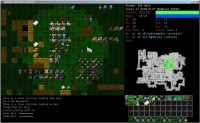Difference between revisions of "Stash"
(0.21: removed some legacy strategy, modernized the approach to stashes.) |
|||
| Line 1: | Line 1: | ||
| − | {{ | + | {{version028}} |
| − | + | Technically, a '''stash''' is any item which has been left on [[the Dungeon]] floor. In more common usage, however, a stash is a centralized location in which a player dumps any items they do not wish to carry around at all times, but which may be useful later. | |
[[Image:Stash.jpg|thumb|right|200px|An elaborately arranged Lair:2 stash.]] | [[Image:Stash.jpg|thumb|right|200px|An elaborately arranged Lair:2 stash.]] | ||
| − | |||
| − | |||
==Strategy== | ==Strategy== | ||
| + | It's very easy to forget where you left a particular item as you explore. Fortunately, pressing '''"CTRL+f"''' brings up a search prompt which allows you to pinpoint where you left your things quickly and easily. This can be used to search for individual items (e.g. scroll of amnesia, +1 helmet), item categories (body armour, Maces & Flails, wand), and even particular resistances or intrinsics. | ||
| − | + | In modern crawl, there's little need to put all your items in one place. You could certainly forget what you need to search for in the first place. But as you get used to what items you drop, even that becomes less relevant. Regardless, it's a good idea to open a few slots in your inventory before entering a timed [[portal]]. Portals permanently close once you leave them, so you don't want to leave any items behind. In many other cases, its trading a few (largely irrelevant) turns in the [[zot clock]] for a more organized Dungeon. | |
| − | |||
| − | |||
| − | |||
| − | |||
==History== | ==History== | ||
| − | * | + | *Many quality of life changes are aimed at reducing inventory management, and thus, a need to stash items at all. [[Scrolls of remove curse]] and [[scroll of identify|identify]] and [[manual]]s in [[0.27]], [[food]] in [[0.26]], and [[spellbook]]s in [[0.22]] are just some of the examples. |
*Prior to [[0.17]], jellies could eat any item left on the floor, putting your stash in grave danger. | *Prior to [[0.17]], jellies could eat any item left on the floor, putting your stash in grave danger. | ||
*Prior to [[0.15]], items could be destroyed through [[item destruction]], forcing the player to risk losing items in the inventory or leave them behind. Also, items had [[aum|weight]] and would eventually be too much of a burden for your character to carry. These facts greatly influenced how players chose what to stash and what to carry. Also, all teleport traps were permanent, and characters with [[stasis]] could use them as untouchable stash sites. | *Prior to [[0.15]], items could be destroyed through [[item destruction]], forcing the player to risk losing items in the inventory or leave them behind. Also, items had [[aum|weight]] and would eventually be too much of a burden for your character to carry. These facts greatly influenced how players chose what to stash and what to carry. Also, all teleport traps were permanent, and characters with [[stasis]] could use them as untouchable stash sites. | ||
Revision as of 06:51, 8 April 2022
Technically, a stash is any item which has been left on the Dungeon floor. In more common usage, however, a stash is a centralized location in which a player dumps any items they do not wish to carry around at all times, but which may be useful later.
Strategy
It's very easy to forget where you left a particular item as you explore. Fortunately, pressing "CTRL+f" brings up a search prompt which allows you to pinpoint where you left your things quickly and easily. This can be used to search for individual items (e.g. scroll of amnesia, +1 helmet), item categories (body armour, Maces & Flails, wand), and even particular resistances or intrinsics.
In modern crawl, there's little need to put all your items in one place. You could certainly forget what you need to search for in the first place. But as you get used to what items you drop, even that becomes less relevant. Regardless, it's a good idea to open a few slots in your inventory before entering a timed portal. Portals permanently close once you leave them, so you don't want to leave any items behind. In many other cases, its trading a few (largely irrelevant) turns in the zot clock for a more organized Dungeon.
History
- Many quality of life changes are aimed at reducing inventory management, and thus, a need to stash items at all. Scrolls of remove curse and identify and manuals in 0.27, food in 0.26, and spellbooks in 0.22 are just some of the examples.
- Prior to 0.17, jellies could eat any item left on the floor, putting your stash in grave danger.
- Prior to 0.15, items could be destroyed through item destruction, forcing the player to risk losing items in the inventory or leave them behind. Also, items had weight and would eventually be too much of a burden for your character to carry. These facts greatly influenced how players chose what to stash and what to carry. Also, all teleport traps were permanent, and characters with stasis could use them as untouchable stash sites.
